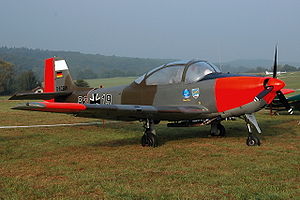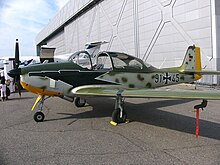| Piaggio P.149 | |
|---|---|

| |
| Role | Utility liaison or training monoplane |
| Manufacturer |
Piaggio Aero Focke-Wulf |
| First flight | 19 June 1953 |
| Primary users |
German Air Force Swissair Flying School |
| Number built | 88 (Piaggio) 190 (Focke-Wulf) |
| Developed from | Piaggio P.148 |




The Piaggio P.149 is a 1950s Italian utility and liaison aircraft designed and built by Piaggio. The aircraft was built under licence by Focke-Wulf in West Germany as the FWP.149D.
Development
The P.149 was developed as a four-seat touring variant of the earlier P.148. The P.149 is an all-metal, low-wing cantilever monoplane with a retractable tricycle landing gear with room for four or five occupants. [1] The prototype first flew on 19 June 1953. [2]
Only a few were sold, until the German Air Force selected the aircraft for a training and utility role. Piaggio delivered 76 aircraft out of a total of 88 built in Italy to Germany, while another 190 were built in Germany by Focke-Wulf. [2] [3]
Operational history
The aircraft was operated by the German Air Force between 1957 and 1990.
Swissair's Flying School based at Bern (Belp) airfield used a small fleet of the type to provide primary instruction to trainee pilots. [3]
Operators
- Italian Air Force operated two Piaggio P.149Ds from 1953 until 1955 [7]
- Nigerian Air Force operated 12 Piaggo P.149D in 1967 [8]
Specifications (P.149D)
Data from Jane's All the World's Aircraft 1958-59 [11]
General characteristics
- Crew: 2
- Capacity: 2-3
- Length: 8.8 m (28 ft 10 in)
- Wingspan: 11.12 m (36 ft 6 in)
- Height: 2.9 m (9 ft 6 in)
- Wing area: 18.81 m2 (202.5 sq ft)
- Aspect ratio: 6.6
- Airfoil: root: NACA 230 series; tip: NACA 4412 [12]
- Empty weight: 1,160 kg (2,557 lb)
- Gross weight: 1,680 kg (3,704 lb)
- Powerplant: 1 × Lycoming GO-480 B1A6 , 200 kW (270 hp)
Performance
- Maximum speed: 304 km/h (189 mph, 164 kn) at sea level
- 285 km/h (177 mph; 154 kn) at 2,000 m (6,600 ft)
- Cruise speed: 266 km/h (165 mph, 144 kn) at 2,300 m (7,500 ft) and 67% METO power
- Stall speed: 92 km/h (57 mph, 50 kn) at sea level with flaps
- Range: 1,090 km (680 mi, 590 nmi) with 30 minutes reserve
- Service ceiling: 6,050 m (19,850 ft)
- Rate of climb: 5 m/s (980 ft/min)
- Wing loading: 89.3 kg/m2 (18.3 lb/sq ft)
-
Power/mass: 0.120 kW/kg (0.073 hp/lb)
- Take-off distance to 15 m (50 ft): 405 m (1,330 ft) in nil wind
- Landing distance from 15 m (50 ft): 315 m (1,030 ft) in nil wind
See also
Related development
Aircraft of comparable role, configuration, and era
Citations
- ^ Stevens 1958, p. 73
- ^ a b Simpson 1995, p. 279
- ^ a b c Gandet 2001, pp. 42–43.
- ^ Wheeler 1980, p. 1339.
- ^ Piaggio P-149D
- ^ "Piaggio P.149D". Israeli Airforce Website. Retrieved 27 July 2016.
- ^ "Italian Air Force". aeroflight. Retrieved 31 May 2019.
- ^ Jowett, Philip (2016). Modern African Wars (5): The Nigerian-Biafran War 1967-70. Oxford: Osprey Publishing Press. p. 17. ISBN 978-1472816092.
- ^ Donald 1997, p. 735.
- ^ Wheeler 1980, p. 1374.
- ^ Bridgman, Leonard, ed. (1958). Jane's All the World's Aircraft 1958-59. London: Jane's All the World's Aircraft Publishing Co. Ltd. pp. 198–199.
- ^ Lednicer, David. "The Incomplete Guide to Airfoil Usage". m-selig.ae.illinois.edu. Retrieved 16 April 2019.
References
- Donald, David. The Encyclopedia of World Aircraft. Leicester, UK: Blitz Editions, 1997. ISBN 1-85605-375-X.
- Gandet, Erich. "'Wulf' in Sheep's Clothing: Farewell to Swissair's P.149s". Air Enthusiast. No. 92. March/April 2001. pp. 42–43. ISSN 0143-5450.
- The Illustrated Encyclopedia of Aircraft (Part Work 1982-1985), 1985, Orbis Publishing, Page 2714.
- Simpson, R. W. Airlife's General Aviation. Shrewsbury, UK: Airlife Publishing Ltd., Second edition, 1995. ISBN 1-85310-577-5.
- Stevens, James Hay. "Fully Aerobatic Four-Seater". Flight, 18 July 1958, p. 73.
- Wheeler, Barry C. "World's Air Forces 1980". Flight International, 4 October 1980. pp. 1323–1378.
External links